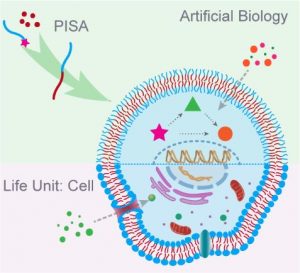All living systems possess fundamental criteria for thriving—manipulating information, constructing their own components from simpler components found in their environment, undergoing system replication, and evolving at the population and system levels.
“Artificial biology” aims to mimic all these essential properties without relying on biochemistry.
The “booting up” phase is pivotal to success in this endeavor, which involves establishing a chemical system with the ability to sustain itself. Research in this area integrates physics, chemistry, biology, computer science, and materials science and is still in its infancy.
One means to “boot up” a chemical system is by polymerization-induced self-assembly (PISA). This valuable methodology has been used by polymer scientists in recent years to construct biomimetic vesicles or artificial procells in artificial biology.
Researchers including Gong Cheng and Juan Pérez-Mercader from the Department of Earth and Planetary Sciences and Origins of Life initiative at Harvard University are making exciting progress in this field.
In Macromolecular Rapid Communications, they describe the current challenges and opportunities in using PISA for realizing the complete, self-organized, and autonomous synthesis of human-designed chemical systems.
Cheng and Pérez-Mercader use a transdisciplinary approach: they model the desired properties using quantitative physics and then translate this into chemistry that can be performed in the laboratory.
 “We follow a design tradition from computer science called “outside in”. It entails going from the general properties of the “living system” to their detailed internal nuts and bolts and eventual construction of a unifying chemical entity capable of concomitantly exhibiting all the (above) properties.
“We follow a design tradition from computer science called “outside in”. It entails going from the general properties of the “living system” to their detailed internal nuts and bolts and eventual construction of a unifying chemical entity capable of concomitantly exhibiting all the (above) properties.
We have a theoretical idea of the complete picture that gives us information on how to accomplish and integrate the several properties, but still a lot relies on direct experimentation which, in turn, feeds the theory and provides guidance to further experiments and sheds light on the path ahead.”
Aside from artificial biology, this research could lead to progress in materials science, computation, physico-chemical implementations of neural networks, soft-robots, and other applications. Challenges that remain include adaptive chemical computation and mitotic-like self-replication with passage of information from one generation to the next.
Only a few years ago, Perez-Mercader and Cheng state, “these challenges looked unassailable, but today they seem within close reach.”
The results achieved in this field to date have brought synthetic non-biochemistry-related life-mimics closer to the laboratory and to the industrial realm, and according to Perez-Mercader and Cheng, they “will also help greatly expand the horizon of possibilities for the existence of life forms elsewhere in the Universe.”
To find out more, read the article here.

















